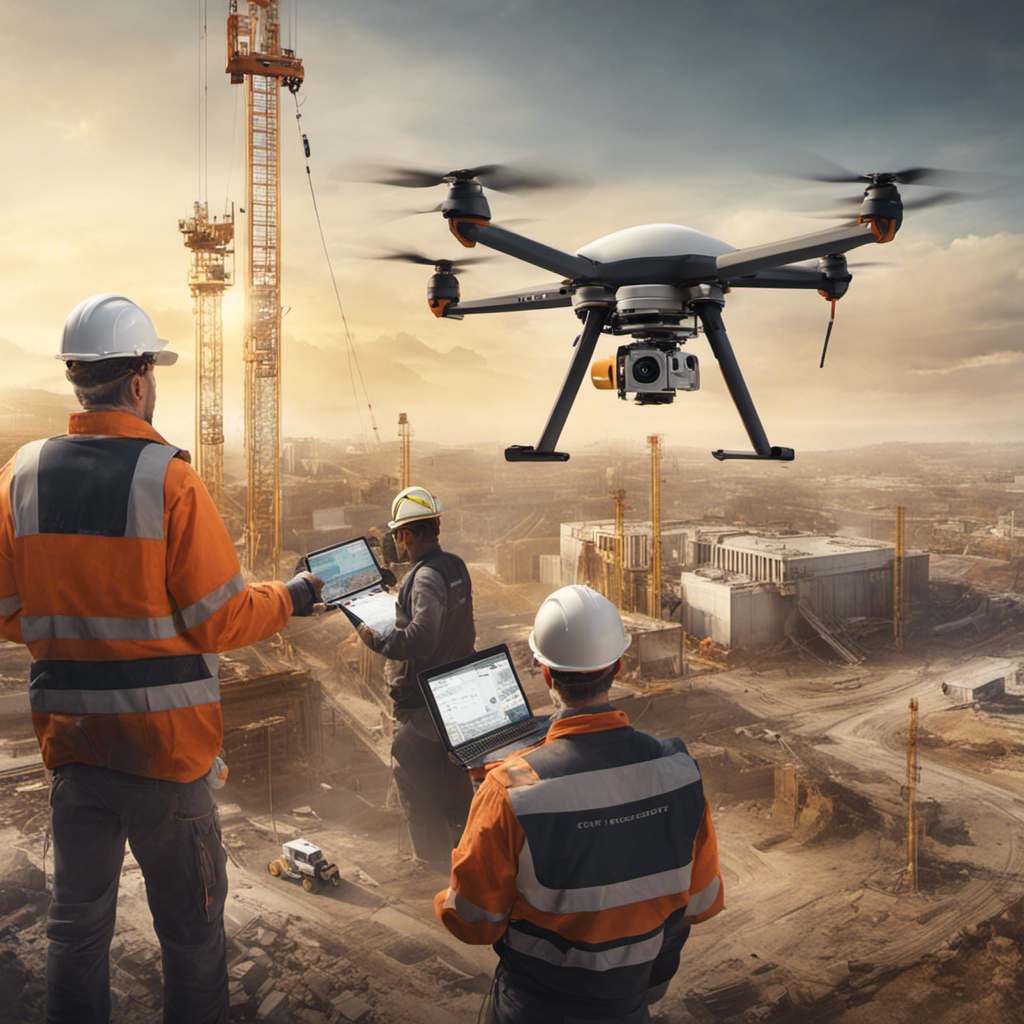Are you ready to embrace the future of delivery services?
In ‘Delivering The Future: Exploring Drone Delivery Services,’ we delve into the exciting world of drone delivery and its immense potential.
Imagine a world where your packages are swiftly transported through the skies, bypassing traffic and reaching your doorstep in record time.
This captivating exploration reveals the rise of drone delivery, with industry giants like Amazon and UPS already leading the way.
Discover the advantages and limitations of this innovative technology, and gain insights into how it works.
While challenges exist, such as regulatory issues and weather conditions, the benefits of drone delivery, including scalability and reduced emissions, make it a compelling option for the future.
Join us on this journey as we uncover the possibilities that lie ahead.
Key Takeaways
- Drone delivery services are on the rise, with major industry players like Amazon, UPS, DHL, and Walmart embracing this technology.
- Drone delivery offers advantages such as faster and more sustainable delivery methods, lower operating costs, and increased flexibility and convenience for consumers.
- However, there are limitations to drone delivery, including legislative and regulatory challenges, privacy concerns, weather conditions, and potential interference with other aircraft.
- Despite these limitations, drone delivery has the potential to revolutionize last-mile delivery and play a crucial role in the healthcare sector, particularly in vaccine delivery.
The Rise of Drone Delivery
You may have noticed that drone delivery services are becoming more prevalent in recent years. The demand for drone delivery has skyrocketed, especially in the wake of the COVID-19 pandemic.
With the global delivery market projected to reach a staggering USD 8 billion by 2027, major industry players like Amazon, UPS, DHL, and Walmart have embraced this technology to meet the evolving needs of consumers.
Drone delivery services offer a solution to the last-mile delivery challenge, enabling faster and more efficient delivery of goods. By leveraging drone technology, companies can overcome obstacles such as traffic congestion and limited access to remote or rural areas.
This innovative approach not only saves time and resources but also offers a sense of freedom and flexibility to consumers who crave convenience in their everyday lives.
Advantages and Limitations of Drone Delivery
When considering the advantages and limitations of drone delivery, it’s important to take into account various factors and challenges.
Drone delivery operations offer numerous benefits, including faster and more sustainable delivery methods. By reducing CO2 emissions and road congestion, they contribute to a cleaner and more efficient transportation system. Additionally, the lower operating costs of drone delivery services provide a significant advantage in terms of cost efficiency compared to traditional delivery methods.
However, there are limitations to the expansion of drone delivery services. Legislative and regulatory challenges, such as altitude restrictions, weight limitations, and privacy laws, can hinder their growth. Moreover, weather conditions can impact the efficiency and reliability of drone delivery operations. Rain, wind, and snow can pose challenges that need to be addressed to ensure the smooth functioning of drone deliveries.
Despite these limitations, drone delivery services have the potential to revolutionize last-mile delivery and play a crucial role in delivering medical goods in the healthcare sector, highlighting their societal benefits and future growth potential.
How Drone Delivery Works
To understand the mechanics behind drone delivery, let’s delve into the intricate process of how these unmanned aircraft navigate their way to deliver packages efficiently and securely.
Drone deliveries are made possible through the use of commercial drones, which are equipped with advanced technology and capabilities. Before takeoff, the drone’s flight plan is carefully programmed, taking into account factors such as weather conditions, airspace regulations, and optimal routes.
Once in the air, the drone uses a combination of GPS, sensors, and onboard cameras to maintain stability and navigate its way to the designated delivery location. Safety is a priority, and the Federal Aviation Administration has established regulations and guidelines to ensure the responsible operation of commercial drones.
From medical supplies to retail products, drone deliveries have a wide range of use cases and are revolutionizing the way goods are transported, offering speed, efficiency, and accessibility to customers.
The Impact of Drone Delivery on Businesses
Drone delivery has significantly transformed businesses, revolutionizing the way goods are transported and offering numerous benefits. One of the key impacts of drone delivery is its ability to reach remote areas that are otherwise difficult to access. By utilizing vertical take-off and landing capabilities, drones can navigate through challenging terrains and deliver essential goods to customers in remote locations. This opens up new markets and opportunities for businesses to expand their reach and serve previously untapped customer bases.
Furthermore, drone delivery has also had a profound impact on the logistics industry. Traditional delivery methods often face challenges such as traffic congestion and limited capacity, leading to delays and inefficiencies. With drones, businesses can bypass these obstacles and streamline their operations, resulting in faster and more efficient deliveries.
Moreover, drone manufacturers have been quick to adapt to the changing landscape, providing businesses with a wide range of drone models tailored to meet their specific needs. From lightweight drones for small packages to larger ones capable of carrying heavier loads, businesses now have access to a diverse fleet of drones to enhance their delivery services.
Another significant impact of drone delivery is its potential to revolutionize the healthcare industry, particularly in the delivery of vaccines. Drones can transport vaccines to remote and underserved areas, ensuring that even the most vulnerable populations have access to life-saving medications. This not only improves healthcare outcomes but also reduces costs and logistical challenges associated with traditional vaccine distribution methods.
Regulatory Challenges in Drone Delivery
To effectively navigate the evolving landscape of drone delivery, it’s essential for businesses to understand and address the regulatory challenges associated with this innovative technology.
One of the key regulatory challenges is the establishment of altitude restrictions. These restrictions are important to ensure the safety and security of the airspace, as well as to prevent any potential conflicts with other aircraft.
Another challenge is the operational span of the drones. While drones have the potential to deliver goods quickly and efficiently, there are limitations on how far they can travel and how long they can stay in the air.
Weight limitations also need to be taken into consideration, as drones have specific payload capacities that must be adhered to.
Privacy laws are another major concern, as drones have the ability to capture images and collect data, raising questions about how this information is used and protected.
Additionally, navigable airspace regulations need to be established to ensure that drones don’t interfere with other aircraft or pose a risk to public safety.
The limited availability of skilled and experienced resources in the drone delivery space further complicates regulatory considerations.
High initial implementation and set-up costs for drones, including infrastructure, licenses, software, training, and research, present another challenge for drone delivery providers.
Public acceptance is also hindered by privacy, safety, and security concerns, forming a significant regulatory challenge.
Furthermore, weather conditions like rain, wind, and snow impact the efficient operation of drone delivery services, requiring additional regulatory measures to ensure safe and reliable operations.
Frequently Asked Questions
What Is the Future of Drone Deliveries?
The future of drone deliveries looks promising. Technological advancements will improve efficiency, but regulatory challenges must be addressed. Environmental impact will decrease with reduced CO2 emissions, and consumer acceptance will play a crucial role in its widespread adoption.
What Are 3 Potential Problems With Drone Delivery Services?
One potential problem with drone delivery services is the regulatory challenges, including altitude restrictions and weight limitations. Safety concerns, such as weather conditions, can also impact efficient operations. Additionally, privacy issues and technological limitations are significant obstacles to overcome.
What Are Three Benefits to Drone Delivery Services?
Drone delivery services offer numerous advantages. Firstly, they enhance efficiency by delivering goods quickly and directly. Secondly, they provide convenience by reaching remote areas. Lastly, they ensure safety by reducing human contact during the delivery process.
Are Drones the Future of Logistics?
Drones, the future of logistics? You bet! With advancements in technology and customer acceptance on the rise, it’s clear that drone delivery holds immense potential. Plus, it’s environmentally friendly and can bypass pesky traffic regulations.




